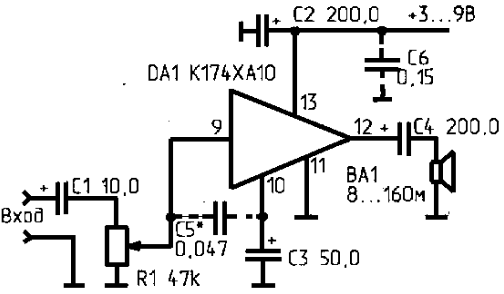
|
|
ENCYCLOPEDIA OF RADIO ELECTRONICS AND ELECTRICAL ENGINEERING A simple amplifier on a K174XA10 chip. Encyclopedia of radio electronics and electrical engineering
Encyclopedia of radio electronics and electrical engineering / Transistor power amplifiers Gone are the days when radio amateurs, as one of the first designs, assembled tube audio frequency amplifiers (UZCH). Bulky output and power transformers determined the final weight and dimensions of the device, high levels of supply voltages, required the use of high-voltage smoothing capacitors in the anode and screen power filters, and created a risk of electric shock. A significant lamp filament current was also required, which reduced the efficiency of the amplifier and created additional (unjustified) heating. To bring to a state of readiness after switching on, it took some time (to warm up the cathodes of the lamps) or it was necessary to keep the cathodes of the lamps heated. Let us pay tribute to the lamps and note that transistor and integrated ultrasonic frequencies are free from all of the listed shortcomings. But some transistor amplifiers are superior in manufacturing complexity to tube ones, and integrated ones require a large number of additional "attached" elements, which negates their advantages from the use of microcircuits. But nothing stands still, and, in my opinion, the last difficulty has also been overcome. True, such a convenient circuit suddenly turned out to be part of a more complex combined analog integrated circuit (IC) K174XA10, although it would be useful to have such a "chip" separately. As can be seen from the circuit diagram (see figure), UZCH contains a minimum of details and can be very widely used. The advantage of this IC is also the prospect for a novice radio amateur, after "running in" the UZCH and studying the capabilities of the IC [1,2], to assemble an AM receiver on the same chip, and then a combined one - AM-FM.
Imagine a typical everyday picture: after connecting the Dandy game console to the TV (as usual - with one cord to the antenna jack) and turning on the power of the console, the neighbors suddenly begin to behave like children - knock on walls, on batteries, come as uninvited guests to express their attitude towards you for the interference that appeared on their TVs! The mood for the game, as a rule, then deteriorates greatly. But many TVs have a "video input", and "Dandy" has a video output, they need to be connected to each other, but at the same time, with a high-quality "picture" on the TV screen, the game becomes "dumb". To return the "voice", you need to connect the "Dandy" output to the UZCH input of the TV, but this, as a rule, is not there and you need to "climb" into the TV. To avoid this, you can make the proposed UZCH, connect it to the AF output of the set-top box - and the problem is solved. The input signal of the AF, having passed the isolation (DC) capacitor C1, is fed to the volume control R1, and from its engine to the input of the IC, is amplified by it and through the isolation capacitor C4 is fed to the loudspeaker (dynamic head) VA1. The amplification of the IC depends on the capacitance of the capacitor C3, it is not recommended to greatly reduce it. C2 provides decoupling of the UZCH cascades (inside the IC) for power, and also contributes to the stability of the UZCH when powered by discharged batteries. C5 and C6 increase the resistance of the amplifier to self-excitation, and C5 also affects the frequency response. UZCH. C5 and C6 are optional and are installed only when necessary. Oxide capacitors can be used of any brand, the resistor R1 of the volume control - if possible, group B, which provides smoother adjustment of the sound level. Dynamic head BA1 - any type with a resistance of 8 ... 16 ohms, it is important that the connecting wires be as short as possible, since with long wires, part of the output power is lost on them, since these wires are part of the UZCH load resistance. The amplifier can serve as a separate unit wherever it is necessary to raise the level of the AF signal for perception by the human ear: in a tape recorder, player, as part of various probes, loud-speaking toys, apartment calls, as an ultrasonic frequency converter for detector receivers, for example, in the country, etc. UZCH is not critical to the supply voltage and consumes a small current, but provides high-quality sound reproduction. Those who rely on more gain should use a higher supply voltage. The author deliberately does not give the technical data of the amplifier: they fully correspond to those given in [1] and do not need comments. References:
Author: V.Popov
Machine for thinning flowers in gardens
02.05.2024 Advanced Infrared Microscope
02.05.2024 Air trap for insects
01.05.2024
▪ E-bike with face recognition ▪ Odysseus didn't live in Ithaca ▪ Super glue will close wounds in the stomach and stop the leakage of acids in the plant ▪ There are more cell phones than toothbrushes
▪ section of the site House, household plots, hobbies. Article selection ▪ Bluebeard article. Popular expression ▪ article What is mistletoe? Detailed answer ▪ article Stone-cutting circular saw. home workshop ▪ article Spectators can't guess which hand the coin is in. Focus Secret
Home page | Library | Articles | Website map | Site Reviews www.diagram.com.ua |






 Arabic
Arabic Bengali
Bengali Chinese
Chinese English
English French
French German
German Hebrew
Hebrew Hindi
Hindi Italian
Italian Japanese
Japanese Korean
Korean Malay
Malay Polish
Polish Portuguese
Portuguese Spanish
Spanish Turkish
Turkish Ukrainian
Ukrainian Vietnamese
Vietnamese

 Leave your comment on this article:
Leave your comment on this article: